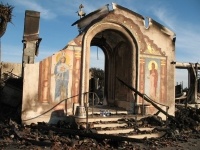c. 2008 Religion News Service
SANTA BARBARA, Calif. _ For more than 60 years, Mount Calvary Monastery sat as a patch of holy ground high atop the Santa Barbara hills, home to seven Benedictine Anglican monks whose only jobs in life were prayer and welcoming pilgrims.
Now, after one of the most devastating fires to ever hit Southern California, visitors are left with a different kind of religious experience _ a pile of charred ruins.
As drivers make their way to the monastery along narrow roads, banners hanging from side posts thank firefighters. Green vegetation turns to black-dusted earth.
Mount Calvary’s guests no longer read or pray; they snap pictures of the remains of the retreat house. The tall, steel cross that framed the courtyard, the golden bell that called the monks to prayer, the painted archway that greeted visitors, are all still there.
There is, however, little else.
Charred cacti form a barrier between the parking lot and what was once a 20,000-square-foot, Spanish-style home. A narrow brick wall divides the property from the burned mountains underneath. And the hilltop provides a commanding view of the town that the fickle fire largely spared.
The ruins of Mount Calvary _ a small pile of books and furnishings in a corner _ are sad reminders of what once was. The vast heaps of rubble, the partially eaten walls, and the collapsed beams all call attention to the supremacy of nature, rather than the supernatural. Guests of the mountaintop now appear to be in awe of _ not God’s power _ but the command of fire.
The recent California wildfires burned close to 40,000 acres and destroyed hundreds of homes. The cost of fighting the fires in Santa Barbara alone is said to be close to $6 million. And yet it is the destruction of the home of a small Episcopal community that has captured the attention of so many.
“I’m touched with how concerned people are for us,” said Brother Nicholas Radelmiller, the monastery’s prior, as he sat at Saint Mary’s Retreat House, a women’s Episcopal community that has opened its doors to the seven homeless monks from Mount Calvary.
On the evening of Nov. 13, Radelmiller settled down for dinner. Among the others in attendance were Brother Laurence Harms, a monk with a telescope and a passion for astronomy; Brother Roy Parker, an Episcopal priest who practiced the art of calligraphy; and 25 house guests whom the monks were working to feed.
Then the orange flames began creeping ever closer.
“We could see flames a couple of ridges away through the dining room windows,” said Radelmiller, whose pink button-up shirt, tan pants, and thinly rimmed glasses showed little signs of the distress he had recently experienced at the age of 68. “It looked like the fire was getting pretty close at that point.”
The guests were the first to leave, though they fully expected to be back the next day. “It looked like Mount Calvary was well-defended enough,” said Radelmiller. “There was no panic.”
Nevertheless, the brothers grabbed what they could as they prepared their escape. Radelmiller was the only one of the monks to stow his two habits. Radelmiller knew he had stored his cross _ technically, the only item a monk owns _ in the pocket of one of the garments.
Underneath one arm, Radelmiller also carried the painting of the Virgin of Guadalupe that had hung in the chapel. He was especially fond of the portrait, and it was one of the monks’ few portable items.
The other items the brothers managed to fit into the car are but a miserable sample of the treasures housed in the decades-old monastery. Nearly everything was lost in the fire, including an antique gold altar from South America and a 17th-century painting of Jesus healing the paralytic.
But “much of what we’ve all lost is replaceable,” said Radelmiller. “I think the important thing for anyone is that they’re alive.”
Radelmiller says what he and the other monks miss most is having a place to call their own, a place to receive the thousands of yearly guests.
Like many other Benedictine monks, the brothers earned their livelihood through the ministry of hospitality. Now, the monks are not only without a home but have lost their way of making a living.
“Neither we nor the sisters have been able to reach a decision,” about how long to stay at Saint Mary’s, Radelmiller said.
Although the Order of the Holy Cross, the Episcopal order to which the monastery belongs, does receive donations, the community of monks is largely self-supporting.
And although the fires have put the Santa Barbara monastery in the limelight, the Anglican monks who lived there are relatively unknown. Many assume Protestant monasteries disappeared after the Protestant Reformation, yet the United States and Canada are home to 23 distinct Episcopal/Anglican orders of men’s and women’s religious communities.
Radelmiller says that the four communities belonging to the Order of the Holy Cross will meet next summer and likely make a decision about the fate of Mount Calvary then.
Friar James Huntington established the Order of the Holy Cross in New York before the turn of the 20th century. When the order looked to establish a community on the West Coast, they settled on Santa Barbara after a thorough search.
“Now that Mount Calvary is gone,” Radelmiller said, “we have to start that process over again.”
KRE/CSW END FOWLER900 words
A photo of the burned Mount Calvary monastery is available via https://religionnews.com





